
Romblon, officially the Province of Romblon, is an archipelagic province of the Philippines located in the Mimaropa region. Its main components include Romblon, Romblon, an archipelagic municipality of the same name that also serves as the provincial capital; Tablas, the largest island, covering nine municipalities ; Sibuyan with its three towns; as well as the smaller island municipalities of Corcuera, Banton, Concepcion, San Jose. The province lies south of Marinduque and Quezon, east of Oriental Mindoro, north of Aklan and Capiz, and west of Masbate. According to the 2020 census, it has a total population of 308,985.

Intramuros is the 0.67-square-kilometer (0.26 sq mi) historic walled area within the city of Manila, the capital of the Philippines. It is administered by the Intramuros Administration with the help of the city government of Manila.
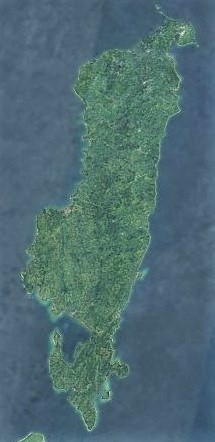
Tablas is the largest of the islands that comprise the province of Romblon in the Philippines. The name of the island is of Spanish origin. Before the colonization of the Philippines, Tablas was known as the Island of Osigan. At the time of contact with Westerners, Osigan had a population of 256 people living in small villages. Wax was produced in this island.
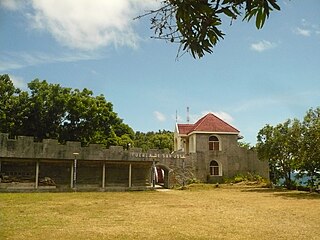
Banton, officially the Municipality of Banton, is a 5th class municipality in the province of Romblon, Philippines. According to the 2020 census, it has a population of 5,737 people.
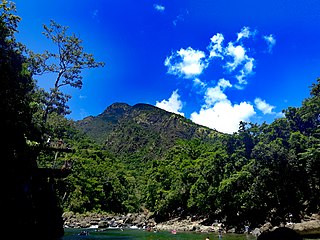
Cajidiocan, officially the Municipality of Cajidiocan, is a 3rd class municipality in the province of Romblon, Philippines. According to the 2020 census, it has a population of 23,259 people. The municipality is located on Sibuyan Island, which has been dubbed as the "Galapagos of Asia" due to its pristine natural environment and high endemism rate for flora and fauna.

Romblon, officially the Municipality of Romblon, is a 3rd class municipality and capital of the province of Romblon, Philippines. According to the 2020 census, it has a population of 40,554 people. The archipelagic municipality is the capital of the province of Romblon and the seat of its provincial government. It includes Romblon Island as well as the nearby islands of Lugbon, Alad and Cobrador.

San Andres, officially the Municipality of San Andres,, is a 5th class municipality in the province of Romblon, Philippines. According to the 2020 census, it has a population of 15,940 people.

San Jose, officially the Municipality of San Jose, is a 5th class municipality in the province of Romblon, Philippines. According to the 2020 census, it has a population of 11,759 people.

Santa Fe, officially the Municipality of Santa Fe, is a 5th class municipality in the province of Romblon, Philippines. According to the 2020 census, it has a population of 17,802 people.

The Minor Basilica and Parish of San Sebastian, also known as the Shrine of Our Lady of Mount Carmel and commonly known as San Sebastian Church or San Sebastian Basilica, is a minor basilica of the Roman Catholic Church in Manila, Philippines. It is under the jurisdiction of the Archdiocese of Manila.
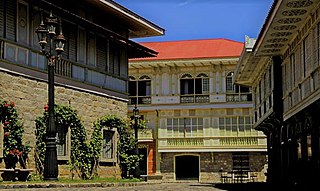
The architecture of the Philippines reflects the historical and cultural traditions in the country. Most prominent historic structures in the archipelago are influenced by Austronesian and American architectures.

The Spanish fortifications of the Philippines, or fuerzas, are strongholds constructed by Filipinos and Spaniards primarily for protection against local and foreign aggressors during the Spanish colonial period, and during the subsequent American and Japanese occupations. Structures built included fortresses, watchtowers, and bastions. Many are badly damaged, either due to old age or past conflicts. Currently, there are initiatives for restorations of all forts, beginning when the Baluarte Luna of La Union and the Intramuros of Manila were restored in the 2010s. In 2013, a typhoon and earthquake hit Central Visayas and damaged numerous Spanish fortifications, leading to the largest restoration activity for fortifications in Philippine history.

Saint Nicholas of Tolentino Parish Church, commonly known as Banton Church, is a Roman Catholic church in the municipality of Banton in Romblon province in the Philippines. It is under the jurisdiction of the Diocese of Romblon. The church is allegedly one of the oldest churches in the country, constructed between 1644 and 1650 during the Spanish colonial period. The façade and tower of the present church is Modern.

The Fort of Saint Vincent Ferrer or commonly known as Punta Cruz Watchtower (Tagalog: Bantayan ng Punta Cruz) is a Spanish colonial era watchtower located at the western tip of the municipality of Maribojoc, Bohol, Philippines. Also known as Maribojoc Watchtower because of its geographical location, it is located three kilometers (1.9 mi) away from Maribojoc Church. It is known for being the "only perfect isosceles triangle" tower-fort structure in the Philippines.
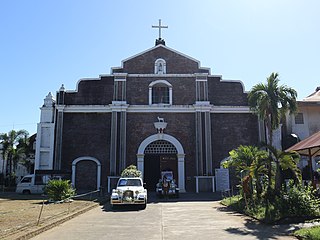
Saint Andrew the Apostle Parish, commonly known as Bacarra Church, is a Roman Catholic church located in the municipality of Bacarra, Ilocos Norte, Philippines under the jurisdiction of the Diocese of Laoag.

The Diocesan Shrine and Parish of San Andres, commonly known as Masinloc Church, is an 18th-century Baroque Roman Catholic church located at Brgy. South Poblacion, Masinloc, Zambales, Philippines. The parish church, dedicated to Saint Andrew the Apostle, is under the jurisdiction of the Diocese of Iba. The church structure, a standout among Spanish-era churches in the Central Luzon region for having been built with coral stone instead of adobe stone, was declared a National Cultural Treasure by the National Museum of the Philippines along with 25 other Spanish-era churches in 2001.

The Historic Bridges of Romblon are a group of bridges that were built during the Spanish and American colonial era over the Casalogan River in the town of Romblon, Romblon in the Philippines. In March 2013, these bridges were declared an Important Cultural Property by the Philippine government and was placed under the protection and conservation of the National Museum of the Philippines.

Saint Joseph Cathedral Parish, commonly known as Romblon Cathedral, is a Roman Catholic cathedral in Romblon town, in the province of Romblon, Philippines. One of the province's known landmarks, it is the seat of the Diocese of Romblon and was declared a National Cultural Treasure in 2001 by the National Museum of the Philippines.

Fuerza de San José is a 17th-century Spanish fortification located in the municipality of Banton, on the homonymous island, in Romblon, Philippines. Together with Fuerza de San Andrés and Fuerza de Santiago, it is part of the ancient fortification system of the Sibuyan Sea islands, built under the command of Agustín de San Pedro in order to defend the locals from the attacks that devastated the coasts of the archipelago, especially Moorish incursions from the southern islands. Considered by locals a symbol of greatness and resistance, it played a fundamental role in the defense of Banton in the first decades of Spanish rule of the region, and witnessed numerous battles.






















